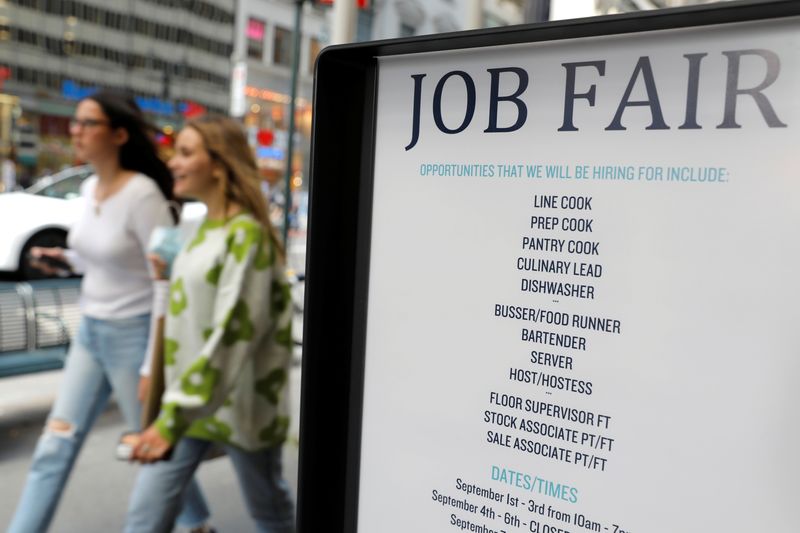By Lucia Mutikani
WASHINGTON (Reuters) -The number of Americans filing new applications for unemployment benefits dropped to an eight-month low last week, pointing to low layoffs at the end of 2024 and consistent with a healthy labor market.
The report from the Labor Department on Thursday added to a recent raft of upbeat economic data, including consumer spending, in reinforcing the Federal Reserve's projections for fewer interest rate cuts this year. Labor market resilience is keeping the economic expansion on track.
"A stable job market will squelch the Fed's appetite for cutting rates aggressively amid nagging services inflation," said Jeffrey Roach, chief economist at LPL Financial (NASDAQ:LPLA).
Initial claims for state unemployment benefits dropped 9,000 to a seasonally adjusted 211,000 for the week ended Dec. 28, the lowest level since April. Economists polled by Reuters had forecast 222,000 claims for the latest week.
There were sharp declines in unadjusted claims in California and Texas. Large increases in filings were recorded in Michigan, New Jersey, Pennsylvania, Ohio, Massachusetts and Connecticut.
Claims tend to be volatile around the end of the year. Through the volatility, however, they have remained compatible with a labor market that is steadily slowing at a pace that does not signal a deterioration in economic conditions.
The four-week moving average of claims, which strips out seasonal fluctuations from the data, fell 3,500 to 223,250.
The dollar rose to a two-year high against a basket of currencies, while stocks on Wall Street were slightly stronger. Yields on longer-dated U.S. Treasuries edged higher.
CONSTRUCTION SPENDING UNCHANGED
The U.S. central bank last month delivered a third consecutive interest rate cut, lowering its benchmark overnight interest rate by 25 basis points to the 4.25%-4.50% range.
It, however, projected only two reductions in borrowing costs this year compared to the four it had forecast in September, acknowledging the resilience of the jobs market and economy. The Fed's policy rate was hiked by 5.25 percentage points in 2022 and 2023 to quell inflation.
The labor market is being underpinned by very low levels of layoffs, but employers are hesitant to add more workers after a hiring spree during the recovery from the COVID-19 pandemic.
As a result, some workers who have lost their jobs are experiencing long bouts of joblessness, with the median duration of unemployment approaching a three-year high in November.
The number of people receiving benefits after an initial week of aid, a proxy for hiring, decreased 52,000 to a seasonally adjusted 1.844 million during the week ending Dec. 21, the claims report showed.
The so-called continuing claims continued to rise in Washington state, long after a strike by factory workers at Boeing (NYSE:BA) ended. They remained elevated in North Carolina in the aftermath of the devastation caused by Hurricane Helene, and in Michigan and Ohio, which have suffered job losses in manufacturing.
Economists have also attributed some of the continued elevation in the so-called continuing claims to difficulties stripping out seasonal fluctuations from the data. They expect the unemployment rate to have held steady at 4.2% in December.
The government is scheduled to publish its closely watched employment report for December next Friday.
"Businesses hired fewer employees in 2024 than they did in 2023 and 2022, leading to the persistent increase in continuing claims in 2024," said Stuart Hoffman, senior economic advisor at PNC Financial (NYSE:PNC). "But the economy is still creating roughly enough jobs to keep up with labor force growth."
A separate report from the Commerce Department's Census Bureau showed construction spending was unchanged in November as a moderate rise in single-family homebuilding was offset by a sharp decline in outlays on multi-family housing projects. That followed an upwardly revised 0.5% rise in October.
Economists had forecast construction spending would gain 0.3% in November after a previously reported 0.4% rise in October. It increased 3.0% on a year-on-year basis in November.
Spending on private construction projects edged up 0.1% after increasing 0.6% in October. Investment in residential construction nudged up 0.1%, with outlays on new single-family projects rising 0.3%.
New construction could be hampered by higher mortgage rates, President-elect Donald Trump's threat to impose tariffs on imports, and the labor shortages that could result from his incoming administration's broad promise to deport immigrants.
Trump's policy pledges, including tax cuts, have contributed to the elevation in mortgage rates even as the Fed has been lowering borrowing costs.
Outlays on multi-family housing units fell 1.3% in November. Spending on home renovations continued to increase.

Investment in private non-residential structures like offices and factories was unchanged in November.
Spending on public construction projects dipped 0.1% in November after easing by the same margin in October. State and local government spending slipped 0.1%, while outlays on federal government projects dropped 0.5%.